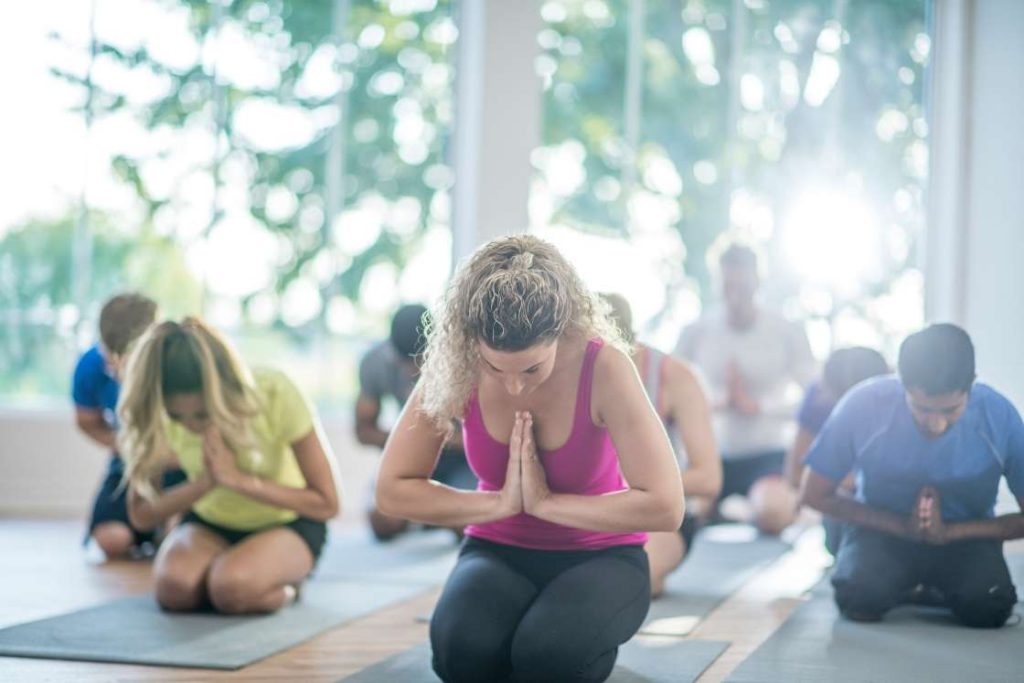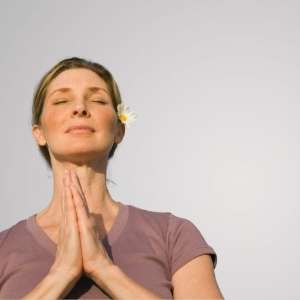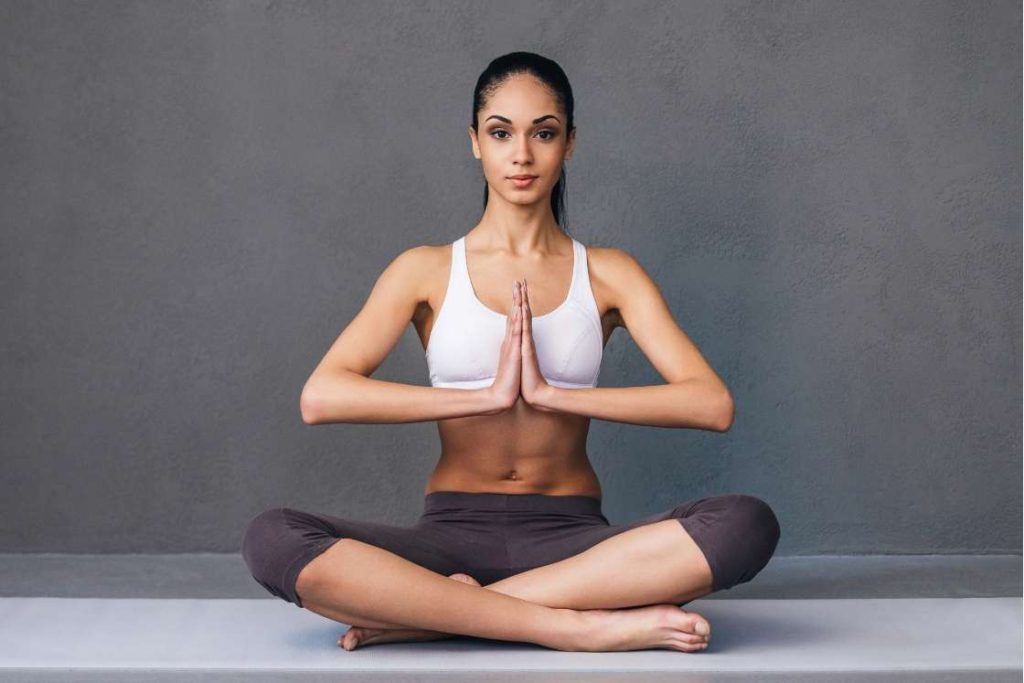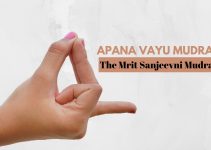
The hand gesture, with palms touching against each other, fingers closed and pointing upward, is a very common sight in Indian culture and so in the yoga tradition. And this common hand gesture, also known as Anjali Mudra, comes with a great range of significance, application, and benefits.
In Indian culture, Anjali mudra is usually used to represent a respectful greeting. A respectful greeting to offer gratitude to the divinity, which is why this gesture is almost always related to worship and prayer-related activities. It’s also known as Namaskar mudra or Namaste in the common language.
The simplicity of Namaste is very strikingly visible, but the depth of its significance often eludes our understanding. This seemingly simple gesture has a lot of systematic thinking behind it, that generates multiple health, intellectual, emotional, and spiritual benefits.
Justifying the term Anjali
“Anjali” is a Sanskrit word that means divine offering or salutation and mudra means gesture we make using hands. Anjali mudra means salutation seal. It’s also known as Namaskar mudra or Namaste in India. It’s made using prayer hands.
The term divinity has got many different layers and choices of interpretation. In yoga, the auspiciousness of Anjali is also associated with Patanjali; the father of yoga. However, there is one fixed perception across all cultures and belief systems and that is, divinity is the unity of all the universal forces, that is the source of all creation.
So when you do Anjali mudra, you are offering to the divinity, the only thing you could possibly offer is a part of that divinity that resides within you. The Anjali Mudra helps you to unite the conflicting forces within your body and activate the small portion of divinity residing in you.
By means of divine offering, this mudra represents the unification of our soul with the supreme soul. Further, this union neutralizes the negative and positive energies within us.
The significance of Anjali Mudra
Your hands, or more specifically your palms, are the ultimate expressive ends of your physical being. It can express your physical health, emotional state, and intellectual being. Think of all the things we do with our hands: we build, we fight, we create art, we farm, we love and we kill.
Every intellect, sense, and emotion, that exists within you has the potential to materialize through your hands. Scientifically speaking, your hands and fingertips are characterized by a complex mesh of nerve endings, that enable your hands to perform various expressive activities.
Union of Opposites

Having understood the importance of your hands, let’s understand the importance of joining your hands in Anjali Mudra or Namaste. Our left and right side of the body represent the duality of all our emotions, intellect, and senses. For example, our likes and dislikes, our cravings and aversions, our sense of logic and intuition, and so on.
When the energies flowing on our left side (In Ida Nadi) and the energies flowing on our right side (In Pingala Nadi) unite, they establish a state of balance. This balance is elemental to our physical and mental well-being. So essentially, when you have any physical or mental disorder, you can be sure there has been a disruption to some form of left-right balance.
Anjali mudra involves joining together both your palms at your heart, in center. This hand gesture brings together the nerve endings on both your hands and as a result, joins the left and right hemispheres of your brain; hence It is a “centering pose”.
When we perform Anjali mudra with our hands in the center of our heart chakra, it helps to alleviate mental stress and anxiety and is therefore used to assist the practitioner in achieving dhyana: the meditative state.
How do we use Anjali Mudra in Yoga Practice?

Anjali Mudra is an important part of yogic practices, including the asana, which represents the most prominent physical aspect of all yogic practices. During the practice of asanas, the Anjali mudra can be performed in three instances: before going into a yoga pose, during the hold, or after the pose.
Before going into a pose: When the Anjali mudra is performed before going into a yoga pose, it is used as a preparatory step. It helps calm your muscles and nerves, and create a harmony of the energies. This harmony will help you approach the posture with greater awareness and efficiency.
When performing yoga poses: When the Anjali mudra is performed while you’re into a yoga pose, it’s done with the intention of magnifying a particular benefit. The Anjali mudra can be performed with Goddess pose, thunderbolt pose, mountain pose in sun salutation etc. It will optimize the flow of energies to specific parts of your body. This will, in turn, increase the stimulation and efficacy of the yoga pose.
After coming out of the pose: When the Anjali mudra is performed at the end of an asana, its intention is to return your mind and body into a state of harmony. This influence can play a pivotal part in keeping your yoga routine injury-free. Some yoga poses can be quite stress-intensive on your mind and body. Such poses will often leave you with a disruption to the harmony of energies within you. Finishing the pose with the Salutation seal, will fix the issue of disruption, and restore harmony.
Anjali Mudra with different hand postures
Equally important to the timing of Anjali Mudra is the placement of hands into the posture. Anjali mudra can be performed with different hand postures; high above your head, directly touching the crown of your head, in front of your forehead, in front of your throat, and in front of your chest.
Each placement, apart from establishing left-right balance, will also benefit a specific group of mind-body biomechanisms.
High above your head: Raising our hand high above the head and joining our hands in Anjali mudra, helps us connect with forces beyond our physical existence.
Our body has seven chakras, or energy centres, which we often hear of in yoga. However, there are other chakras above our body, like the soul star chakra, spirit chakra, universal chakra, and such. If you are looking for meditative tools to connect with the core essence of the universe, this form of Anjali is what you are seeking.

Right above our head: Anjali mudra hands just above the head is called Kailash mudra. The seventh or crown chakra at the top of our head corresponds to spiritual connection. Anjali mudra hands just above the head bridge between the energies within your body and outside. It helps you attain spiritual awakening.

Right in front of your forehead: It’s the location of the third eye chakra that corresponds to your pineal gland. When Anjali mudra is performed with hands keeping on the forehead, it’s known as Namaskar mudra, Pranam mudra or Prayer mudra. In terms of bodily functions, Namaskar mudra will enhance your awareness and nervous functions. The forehead chakra, or your third eye, is the link between your spiritual and materialistic existence.

Right in front of your throat: When you perform the Anjali mudra keeping hands in front of the throat, your throat physiology and the surrounding region will receive health benefits. It will improve your vocal functions and resist infection in the throat region. Our vocal apparatuses are considered the most critical medium of human communications. Thus performing Anjali mudra in front of your throat will also bring harmony to the energies involved in the communication process.

Right in front of your heart: Your heart chakra or the heart region is elemental to benefit your blood flow and oxygen management. Postures that benefit your respiratory and cardiovascular functions often accompany the Anjali mudra in front of the chest.

Can you feel the difference in energy in these variations?
When you join your hands in front of your forehead, your unity of energies come in alignment with your pineal glands. This should make you feel more focused and aware, sharpening your senses of perception. On the contrary to the chest that optimises your blood flow and respiration, makes you feel more relaxed.
As you extend your hands over your head and further up, you will experience new energies, energies that exist outside your body. Your senses of perception will reach out to connect with the universe around you. You will be able to achieve, in yogic terms what is known as a state of absorption.
How do we use Anjali Mudra in daily life?
Apart from being used as a mudra in yogic practices, the Anjali mudra is a gesture, deeply embedded in the body language of the Indian culture. Throughout the course of a regular day, the Anjali Mudra is applied to different types of activities.
1. To worship
The foremost use of the Anjali mudra in our regular life is as a worshiping gesture. With the Anjali Mudra, we offer our gratitude to the divinity. This gesture represents our surrender and complete submission to the divine forces.
Anjali mudra as a worshipping gesture represents respect and gratitude to the higher power. In other words, we use this gesture to say thanks and show gratitude for everything we have; reflecting joy and Bhakti.
This gesture can be used to worship anything you believe in: it can be a god, a person, or anything you respect to. it can be a form of meditation where you simply surrender your being and express your gratitude to the source of all creation.
2. To greet someone
As Anjali mudra is a gesture of salutation, in India, it’s used to greet someone you respect. As a greeting gesture, It’s called Namaste.
Namaste is a combination of two words namah+te. Namah means to bow and te means you. It means ‘I bow to you.‘
In India, we are taught that doing Namaste shows a good manner. It is quite similar to saying hello, with an ingredient of respect. In many parts of India, we greet our elders by bowing down and touching their feet, followed by a namaste hand gesture. It shows the respect we bore for our elders.
In Indian culture, the Anjali mudra is also used to thank parents, teachers and mentors, for blessings and support. In aggregate Namaste indicates respect and humility. It indicates “I bow the divine soul within me to the divine soul within you.”
3. To request something from someone
Depending upon the situation, the Anjali hand gesture could also suggest a polite way of requesting. The hand gesture emphasizes that you are imploring from the most divine part of your soul; this signifies an honest and sincere request. The bound hand gesture also gives an automatic indication of submission and peace. Attributes that compliment well, the purpose of the request.
How to Practice Anjali Mudra?

Anjali mudra is among the easiest mudras you can perform easily anytime anywhere. You just need to join the palms of your hands, fingers facing upwards, and thumbs close to your chest. You can perform this mudra in any comfortable sitting or standing position. Or, to perform it in a yoga session, you have to follow the following steps.
- Firstly, come in a comfortable yoga asana, such as sukhasana, tadasana, or vrkshasana keeping the torso straight and upright.
- Now, touch the palm of both hands together, and follow the same with your fingers. Keep your fingers straight pointed upwards, but close the gap between your fingers. Make sure to apply only gentle pressure in maintaining your gesture, and do not force to close the gap in the middle of your palms.
- Bring your hands toward the chest region such that your thumbs touch your breastbone.
- Keep your elbow straight and parallel to the ground.
- Lastly, close your eyes, breath ‘in and out through your nostrils to regulate the flow of prana within you.
- You can also chant OM for better concentration. Chanting OM will help you to meditate
For the Anjali Mudra to work at its best, will need unfettered concentration on your part. To be able to provide that you will find mornings, to be the best time for practice. This is when your mind is calm and free of all worldly distractions.
Benefits of Anjali Mudra
Anjali mudra enhances the central nervous system by balancing the left and right brain hemispheres. It has relaxing, soothing, and calming effects on the body and mind. Owing to its spiritual quality, Anjali mudra helps you connect the true self within you.
Practicing Anjali Mudra has benefits that relate to your mind-body well being, it includes;
- Reduced mental stress and anxiety
- Promote mindfulness and grounding
- Activate the higher chakras
- Stimulates pineal gland (when prayer hands on forehead)
- Develop attitude of gratitude
- Increase focus
- Creates balance and harmony between logical and emotional brain (left and right side)
- Enhance blood flow
- Develop positive personality
- Helps in spiritual growth
1. Establishes balance between the left and right hemispheres of brain
Some people take it as a matter of pride to have the left hemisphere dominant brains; the left hemisphere is said to be the logic heavy side. However, that is a false sense of satisfaction. The ideal situation is not to have any of the hemispheres dominate the other, but to have a perfect balance between the both.
Our left hemisphere is said to be good at processing logic, math, facts, sequences, linearity and language. Whereas the right hemisphere is said to be the generator for emotion, intuition, visualization, rhythm sense and art. Anjali mudra will help you draw a balance between both the hemispheres and equally tap into their immense potential.
2. Increases Focus and concentration
Everytime you lose focus or fail to concentrate it’s because there is a break in the flow of energy. In the case of concentration, energy flow disruption in neural pathways and cognitive functions. Anjali Mudra, especially when performed in front of the forehead, will highly enhance your awareness, focus and concentration.
3. Enhance blood flow and oxygen management
When the Anjali Mudra is performed in front of the chest, it opens up the energy gateway in your chest, that is the Anahata Chakra. Opening up this chakra cleanses the energy flow in this region. As a result, you achieve enhanced cardiovascular and respiratory functions, and thus, enhanced blood flow and oxygen management. Note, that this benefit is specific to when you perform the mudra in front of your chest.
4. Develop a positive personality
The Anjali mudra is a very humble and friendly mudra. If you can take this mudra beyond the practice of systematic hand gesture, and imbibe it to your lifestyle, wonders will happen to you. You will develop an attitude that is considerate and respectful of all other living beings. Naturally in your social setting, you will become an individual loved and revered.
5. Trigger your spiritual awakening
When you perform the Anjali mudra above your head and high above your head, you tap into the energy gateways that bridge your physical and spiritual existence. With extensive practice, these variations of Anjali mudra will increase your awareness of the universal energies and forces working in the nature around you.
Conclusion
The Anjali mudra is also a gesture to greet strangers and elders; it’s even a formal way of greeting all friends and family. In Hinduism, it is traditionally believed that a small part of divinity resides within every living being. Thus by the way of greeting with Anjali Mudra, we bow down to the divinity within the person we are greeting.
In a literal use, this mudra is usually termed as Namaste, Namaskar, or Pranam. The coinage of the term Anjali Mudra is related to the technical applications of the gesture in the yogic tradition.





Namaste
I really like your posts on the different mudras. Thank you for the thorough explanations, valuable insights and outlining the precautions. Much appreciated ?? and my best wishes to you and your team. ?✨
Thanks for the excellent presentation and, easy to follow and practice instructions.